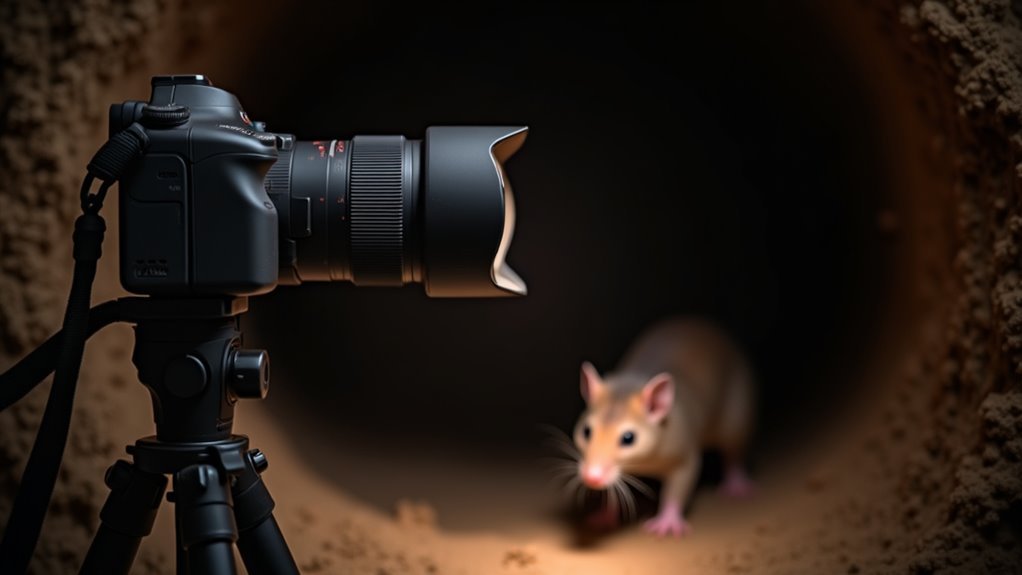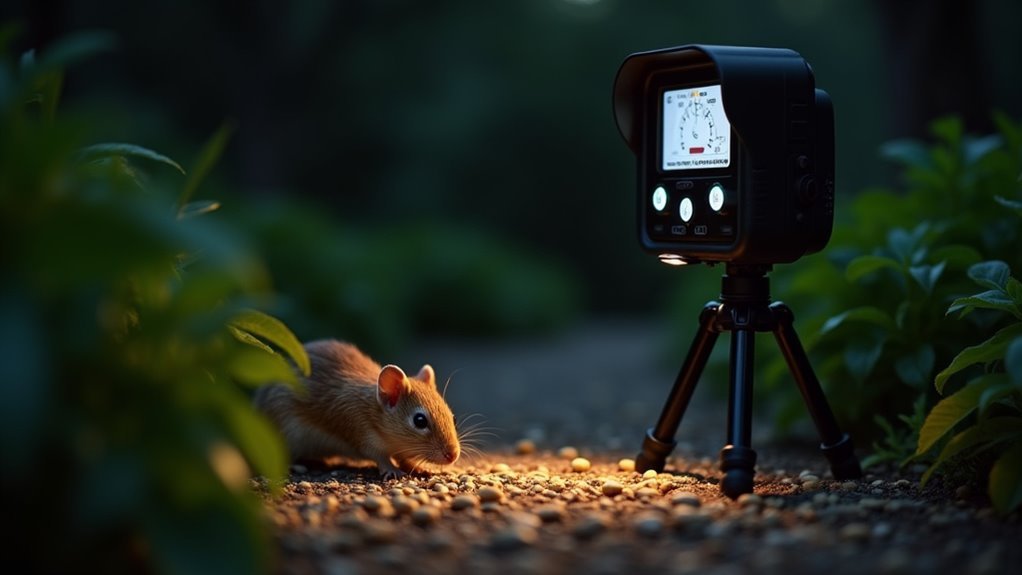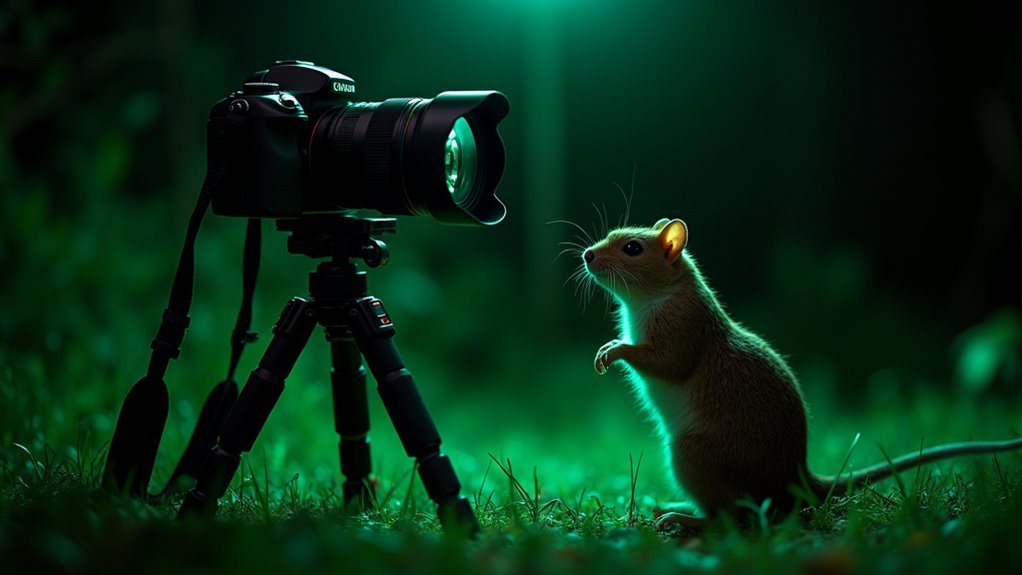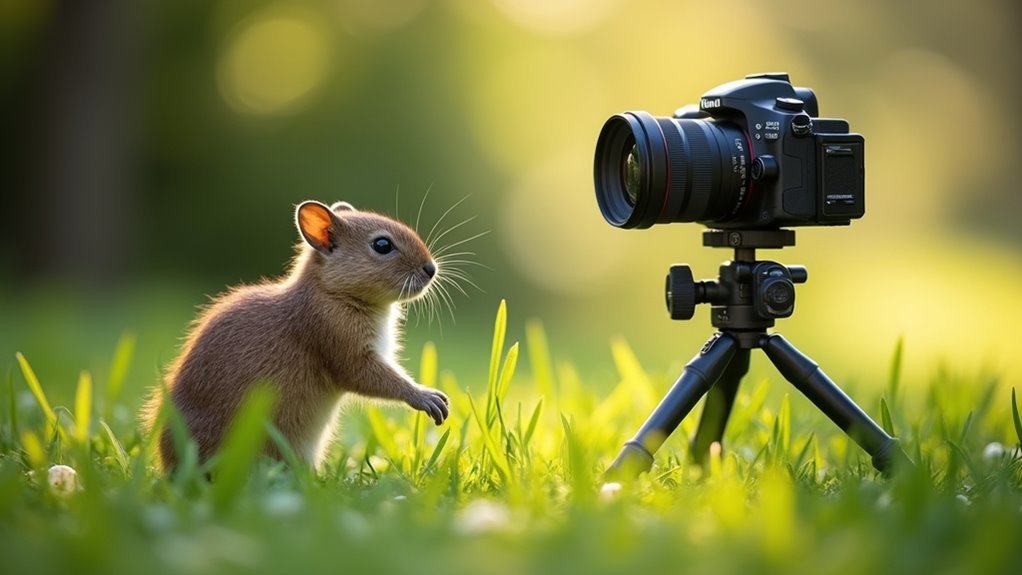You’ll need a high-resolution camera with at least 4K imaging and infrared night vision capabilities to effectively catch rodents. Position your camera 2-3 feet off the ground near entry points like holes and wall gaps, then set motion sensitivity to high for detection ranges up to 100 feet. Choose models with 12-month battery life and weather-resistant housing rated for extreme temperatures. Continuous recording works better than scheduled captures since rodent movements are unpredictable, and the strategies below will maximize your success.
Essential Camera Features for Rodent Detection

When selecting a camera for rodent monitoring, you’ll need high-resolution imaging capabilities of at least 4K or 30 MP to capture clear, detailed footage of these fast-moving creatures.
Your camera must include night vision functionality with infrared capabilities since rodents are most active during nighttime hours.
Look for adjustable motion detection sensitivity that can trigger recordings from at least 100 feet away, providing immediate alerts when rodents approach your monitoring areas.
Battery life is critical—choose models offering up to 12 months of continuous operation to minimize maintenance in harsh weather conditions.
Additionally, prioritize user-friendly interfaces and simple setup options that allow quick deployment across multiple locations, maximizing your coverage and detection effectiveness for thorough rodent monitoring.
Optimal Camera Placement and Positioning Strategies
Since proper placement determines your monitoring system’s success, you’ll want to position cameras strategically at rodent entry points like holes, gaps, and wall edges where these creatures typically travel.
Elevate your cameras 2-3 feet off the ground to improve the camera lens field of view while maintaining focus on high-activity areas. This height prevents obstructions and captures ideal footage of rodent movements.
For maximum effectiveness, follow these positioning strategies:
- Use fixed camera setups instead of pan/scan options to guarantee continuous monitoring of rodent pathways.
- Experiment with different mounting angles to reduce infrared washout that obscures low-light images.
- Review both daytime and nighttime footage regularly to assess installation effectiveness and make necessary adjustments.
This systematic approach guarantees thorough coverage of potential rodent activity zones.
Motion Sensor Settings and Sensitivity Adjustments

You’ll need to understand your camera’s PIR sensor limitations before fine-tuning sensitivity settings for rodent detection.
The ideal detection range varies considerably between camera models, so you’ll want to test your specific unit’s effectiveness at different distances from potential rodent pathways.
Consider how battery wake response times affect your chances of capturing fast-moving rodents, as slower sensors often miss quick scurrying movements.
PIR Sensor Limitations
Although PIR sensors excel at detecting larger animals, they often fail to trigger when monitoring small rodents due to the minimal heat signature these creatures produce. This limitation greatly impacts your trail camera’s effectiveness when targeting mice, rats, or voles.
Cold-blooded creatures like snakes present even greater challenges since they don’t generate detectable heat differences.
Your battery-powered trail camera faces additional hurdles:
- Wake-up delays – The camera often can’t activate quickly enough to capture fast-moving rodents
- Scheduled monitoring – Pre-set active periods rarely align with unpredictable rodent behavior patterns
- Sensitivity trade-offs – Increasing motion detection improves rodent capture rates but creates false triggers from wind, vegetation, or non-target animals
These PIR limitations require alternative detection strategies for successful rodent monitoring.
Optimal Detection Range
Overcoming these detection challenges requires strategic adjustments to your camera’s motion sensor settings and sensitivity levels.
Set your trail game camera’s motion sensitivity to high to enhance detection ranges up to 100 feet, effectively capturing rodent movement from greater distances.
Adjust motion detection settings specifically for smaller animals to prevent missed captures, since standard PIR sensors often struggle with tiny rodents.
Position your camera at ideal height and angle to maximize field view while ensuring the motion sensor detects low-profile animals.
Regularly review recorded footage and fine-tune settings based on results.
This customization enhances captured images, reduces false triggers, and improves detection rates across varying light and weather conditions for consistent rodent monitoring.
Battery Wake Response
When monitoring rodents with battery-powered trail cameras, you’ll encounter wake response delays that can sabotage your capture success. PIR sensors in battery-powered cameras often fail to activate quickly enough for fast-moving rodents, causing you to miss critical footage.
To optimize your motion detection performance, focus on these key adjustments:
- Set trigger speed below 0.5 seconds to capture quick rodent movements without blur.
- Fine-tune motion sensitivity settings to detect smaller animals while avoiding false triggers from environmental factors.
- Test camera placement regularly in various conditions, avoiding areas with fluctuating temperatures that interfere with PIR activation.
You’ll need to balance sensitivity carefully—too low misses rodents, too high creates false triggers from wind or temperature changes.
Regular testing guarantees consistent performance.
Night Vision and Low-Light Performance Requirements

Since rodents are most active during dawn, dusk, and nighttime hours, you’ll need cameras that excel in low-light conditions to capture their natural behavior effectively.
Starlight cameras offer superior night vision and low-light performance compared to standard models, providing clearer visibility in dim environments without disturbing rodent activity.
Your camera should include infrared settings for total darkness situations. This guarantees continuous monitoring even when ambient light is completely absent.
Choose cameras with at least 1080p resolution and 30 fps recording rates to clearly identify fast-moving rodents.
Continuous recording works better than scheduled captures since rodent movements are unpredictable and quick.
While PIR sensors can be useful, remember that small rodents mightn’t always trigger them, requiring careful positioning and sensitivity adjustments.
Frame Rate and Resolution Specifications for Small Animals
Beyond achieving excellent low-light performance, you’ll need cameras that capture rodent movements with precise detail through ideal frame rate and resolution specifications for small animals.
High quality monitoring requires specific technical standards to effectively track these fast-moving creatures.
Essential specifications include:
- Minimum 1080p resolution – Provides clear, detailed images vital for identifying rodent species and analyzing their specific behaviors accurately.
- 30 fps or higher frame rates – Captures fast movements without motion blur, with 60 fps being preferable for documenting rapid rodent actions and nuanced behavioral patterns.
- USB3.0 connectivity – Delivers superior performance over USB2.0, enabling higher frame rates and clearer image quality necessary for monitoring quick-moving targets.
These specifications guarantee you won’t miss critical rodent activity or struggle with unclear footage during analysis.
Bait Placement Techniques to Attract Target Species
With your camera specifications optimized, strategic bait placement becomes your next priority for successfully attracting target rodent species to your monitoring equipment.
Position bait near known entry points like wall gaps or food sources where rodents naturally travel. High-scent baits work best—use peanut butter, sunflower seeds, or dried fruit to effectively entice investigation.
Place bait on raised platforms or within bait stations to encourage direct camera approaches while minimizing non-target interference.
Effective bait placement techniques involve testing multiple bait types simultaneously to determine species preferences from your footage.
You’ll need to refresh bait regularly since stale offerings deter rodents and reduce detection success.
Strategic positioning guarantees rodents enter your camera’s field of view naturally, maximizing your monitoring effectiveness.
Weather-Resistant Housing and Outdoor Installation
You’ll need weather-resistant housing that protects your camera from temperature extremes, typically ranging from -5 to 140°F for reliable rodent monitoring.
Your setup must defend against moisture and rain with water-resistant casings that shield internal components from environmental damage.
Position and mount your camera securely near rodent entry points while ensuring it’s protected from wind and wildlife interference.
Temperature Range Protection
When installing cameras outdoors for rodent monitoring, temperature extremes can quickly destroy unprotected equipment and render your surveillance efforts useless.
You need cameras specifically designed to withstand harsh conditions, like the Bushnell Core DS-4K No Glow, which operates reliably in temperatures from -5 to 140°F (-20 to 60°C).
Your camera selection should prioritize these temperature protection features:
- Robust internal components that won’t freeze or overheat during seasonal changes
- Sealed housing systems that prevent moisture infiltration and thermal damage
- Power-saving modes like those in the Browning Strike Force HD Pro X that reduce heat generation
Proper temperature range protection guarantees your surveillance equipment continues capturing rodent activity year-round, regardless of weather fluctuations that would disable standard cameras.
Moisture and Rain Defense
Moisture infiltration destroys more outdoor surveillance equipment than any other environmental factor, making weather-resistant housing your most critical investment for reliable rodent monitoring.
You’ll need cameras with proper IP ratings that guard against rain and humidity damage. Weather-resistant housing prevents internal condensation that degrades image quality and compromises electronic components over time.
Position your cameras strategically away from direct rainfall exposure while maintaining clear sight lines to rodent pathways. Keep lenses clean and unobstructed for peak visibility. Install units under eaves or natural shelter when possible without sacrificing monitoring effectiveness.
Regular maintenance guarantees long-term reliability. Check housing seals monthly for wear and replace damaged gaskets immediately.
Inspect camera exteriors for cracks that allow moisture penetration, addressing issues before they cause permanent damage.
Mounting and Positioning
Proper mounting transforms your weather-resistant camera housing into an effective rodent detection system that captures clear footage regardless of outdoor conditions.
Strategic positioning guarantees your camera operates effectively in temperatures from -5 to 140°F while maximizing detection opportunities.
Follow these essential mounting guidelines:
- Mount 3-4 feet above ground – This height captures rodents traveling along pathways and near structures without missing low-movement activity.
- Position near entry points – Place cameras close to holes, burrows, or known access routes where rodents frequently travel.
- Angle slightly downward – This positioning improves your field of view while reducing frame obstructions from overhead elements.
Keep infrared sensors unobstructed by foliage or debris to maintain low-light effectiveness.
Proper mounting and positioning turn your weather-resistant housing into a precision rodent monitoring tool.
Battery Life Optimization for Extended Monitoring
Since rodent monitoring often requires weeks or months of continuous observation, optimizing your trail camera’s battery life becomes essential for successful data collection.
Select cameras offering 12-month battery life with standard AA batteries to minimize replacement frequency. Upgrade to high-capacity rechargeable or lithium batteries for superior performance in extreme temperatures compared to alkaline options.
Activate power-saving modes during low activity periods to greatly extend operating time. Configure scheduled event recording or time-lapse features for selective monitoring during non-peak hours, conserving energy when rodents aren’t active.
Regularly adjust motion sensitivity settings to prevent unnecessary battery drain from frequent false triggers.
Proper battery life optimization guarantees your camera remains operational throughout extended monitoring sessions without interruption.
Storage Solutions and Memory Card Recommendations
You’ll need adequate storage capacity to capture continuous rodent activity without missing vital moments.
A minimum 64GB high endurance microSD card provides the foundation for reliable recording, though you should consider 128GB for extended monitoring periods.
High endurance cards withstand the constant write cycles that rodent surveillance demands, preventing storage failure during essential observation windows.
Minimum Storage Capacity Requirements
When monitoring rodents with camera traps, you’ll need adequate storage capacity to capture their frequent activity without missing critical moments. Your storage requirements depend heavily on recording settings and monitoring duration.
For reliable rodent surveillance, consider these minimum storage recommendations:
- 64GB microSD card – Adequate for basic monitoring with moderate recording frequency
- 128GB microSD card – Preferred choice for extended monitoring periods and high quality footage
- 256GB+ capacity – Essential for continuous recording or long-term deployments
Continuous recording dramatically increases storage consumption, while scheduled event recording may miss fast-moving rodent actions.
You’ll want high endurance cards that withstand frequent write cycles. Regular footage review and file management help optimize available space, ensuring you don’t overwrite important rodent behavior data.
High Endurance Card Benefits
High endurance microSD cards deliver superior performance for rodent monitoring because they’re engineered to withstand the demanding write cycles that continuous video recording creates.
You’ll experience fewer failures and data corruption compared to standard cards, ensuring your surveillance footage remains intact during critical monitoring periods.
The high endurance card benefits become apparent when you’re tracking fast-moving rodents that appear briefly. These cards prevent recording interruptions that could cause you to miss essential activity.
You’ll also enjoy extended operational periods without frequent card replacements, reducing maintenance time and costs.
Regular formatting maintains ideal performance, keeping your surveillance system running smoothly.
When monitoring rodent behavior patterns over extended periods, you can’t afford equipment failures that compromise your data collection efforts.
Continuous Recording Storage Needs
Although recording quality matters for identifying rodent behavior, storage capacity determines how long your surveillance system can operate without intervention. Your continuous recording storage needs depend on video resolution, frame rate, and monitoring duration. A 64GB high-endurance microSD card provides adequate space for basic setups, but you’ll achieve better results with 128GB cards.
Here’s what you need for ideal storage management:
- Choose high-endurance SD cards – They’re built to handle demanding write cycles from continuous recording.
- Balance video quality with capacity – Higher resolutions consume more memory, reducing recording time.
- Monitor and clear footage regularly – Prevent valuable data from being overwritten and maintain available space.
Scheduled recording saves storage but risks missing fast rodent movements that continuous recording captures reliably.
Machine Learning Integration for Automated Detection
As camera trap technology advances, you’ll find that machine learning integration transforms how you detect and identify rodents in your monitoring projects. Convolutional neural networks process thousands of images more efficiently than manual review, greatly improving detection accuracy for small mammals.
You’ll need to organize and label your images properly before training your machine learning models. The pipeline involves validation and testing phases that enhance performance on your target species. Hyperparameter tuning and image augmentations like flipping and noise addition increase your dataset size and boost detection accuracy.
This automated approach offers a non-invasive alternative to traditional live trapping methods. You can identify individual rodent species and analyze behaviors without manually reviewing each image, making your monitoring efforts more efficient and thorough.
Image Processing Software and Analysis Tools
Once your machine learning models begin processing camera trap data, you’ll need robust image processing software to handle the massive volume of captured footage effectively. A single camera trap can capture up to 5,000 images nightly, making specialized software essential for analysis.
Professional image processing software like EthoVision XT enhances video clarity and accuracy, providing reliable behavioral analysis data. These tools implement systematic pipelines that streamline your workflow:
- Data organization and labeling – Automatically sorts and categorizes captured footage
- Training and validation phases – Processes datasets for CNN model development
- Testing and performance optimization – Validates species identification accuracy
Your software should support hyperparameter tuning and image augmentations like flipping and noise addition. These techniques enrich training datasets, considerably improving your automated rodent detection models’ performance and reliability.
Cost-Effective DIY Camera Trap Assembly
While professional camera trap systems can cost thousands of dollars, you can build an effective DIY setup for under $200 that delivers comparable results for rodent monitoring.
Start with a basic trail camera featuring 1080p resolution and night vision capabilities to capture clear footage during peak rodent activity hours. Mount your camera on a tripod at the ideal height and angle to cover rodent pathways without motion blur.
Place bait strategically near your camera’s field of view to attract subjects consistently. Use a high-capacity microSD card (64GB minimum) for extended recording periods.
This setup works excellently alongside live traps, providing visual documentation of rodent behavior patterns while maintaining humane monitoring practices throughout your property.
Maintenance Schedules and Performance Monitoring
Even the most well-built DIY camera trap system won’t deliver reliable results without consistent maintenance and performance tracking.
You’ll need to establish a structured routine to maximize your setup’s effectiveness in capturing rodent activity.
Your camera performance monitoring should include these essential tasks:
- Weekly cleaning checks – Wipe lens surfaces and remove debris that could obstruct visibility or trigger false alerts.
- Battery monitoring – Replace batteries before they’re completely drained to prevent gaps in surveillance coverage.
- Footage analysis sessions – Review recordings to identify rodent patterns and adjust trap positioning accordingly.
You should also maintain a detailed log documenting image quality issues, detection rates, and any equipment malfunctions.
This data helps you spot trends and optimize your trapping strategy over time.
Frequently Asked Questions
What Device Is Used to Capture Rodents?
You’ll use traps like snap traps, live traps, or glue boards to actually capture rodents. However, if you’re monitoring rodent activity, you’ll need trail cameras with motion sensors and night vision capabilities.
Can a Thermal Camera Detect Rodents?
Yes, you’ll find thermal cameras effectively detect rodents by capturing their body heat signatures. They’re particularly useful in darkness and low-light conditions when rodents are most active, giving you an advantage over traditional cameras.
Will a Trail Camera Detect Mice?
Yes, you’ll detect mice with trail cameras if you’re using high-resolution models with PIR motion sensors. Position them low along walls where mice travel, and use continuous recording since they move quickly.
What Is the Best Way to Catch Rodents?
You’ll catch rodents most effectively by combining snap traps with bait stations, sealing entry points, and using multiple trap types. Place traps along walls where rodents travel, and check them frequently for best results.
In Summary
You’ll catch rodents most effectively by combining infrared trail cameras with motion sensors set to high sensitivity. Position your cameras 6-12 inches above ground level along walls where rodents travel. Use 1080p resolution with 30fps frame rates for clear small animal detection. Install multiple units at entry points and feeding areas. Monitor footage daily and adjust sensitivity based on results. With proper placement and settings, you’ll document rodent activity patterns successfully.





Leave a Reply